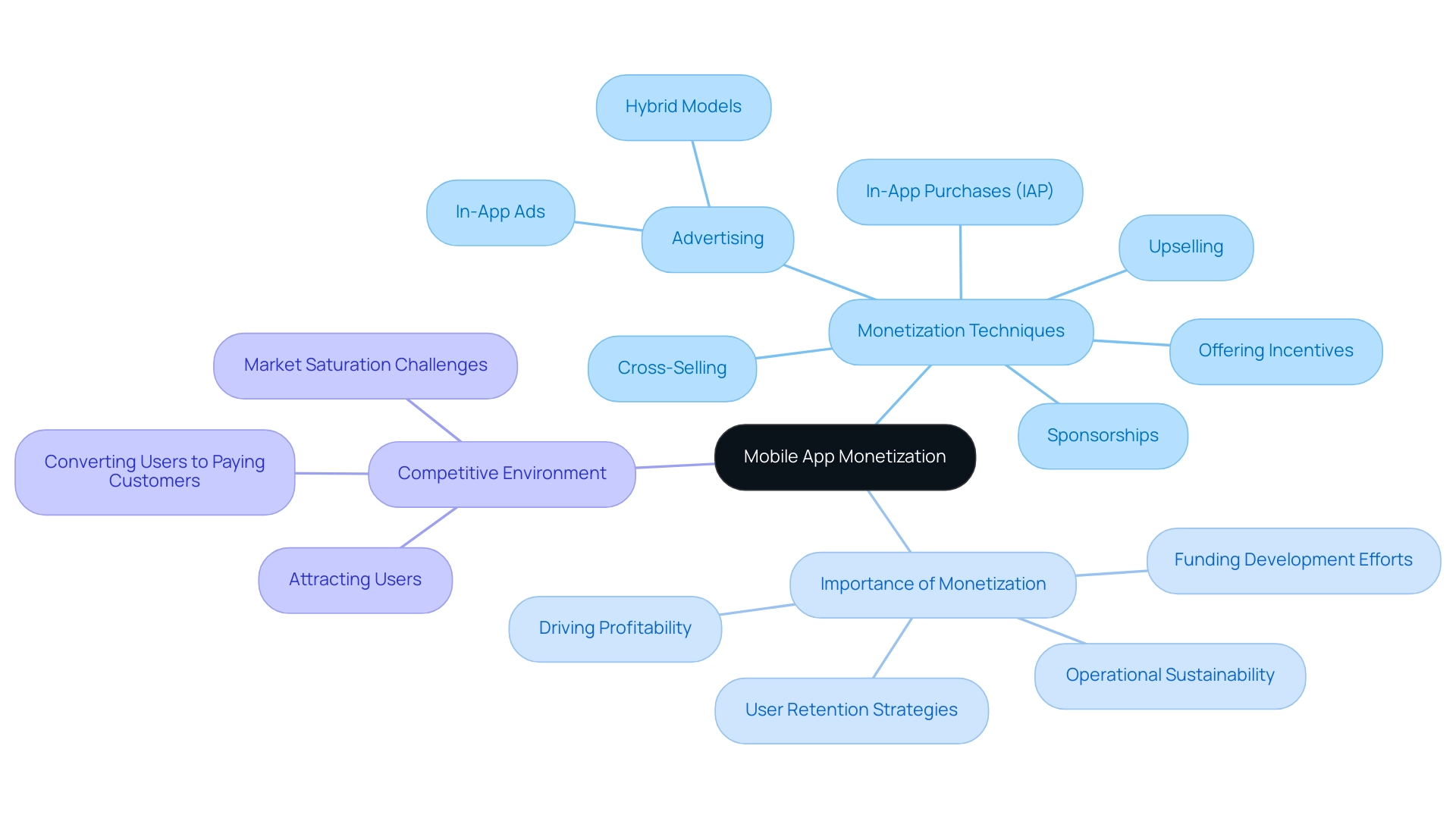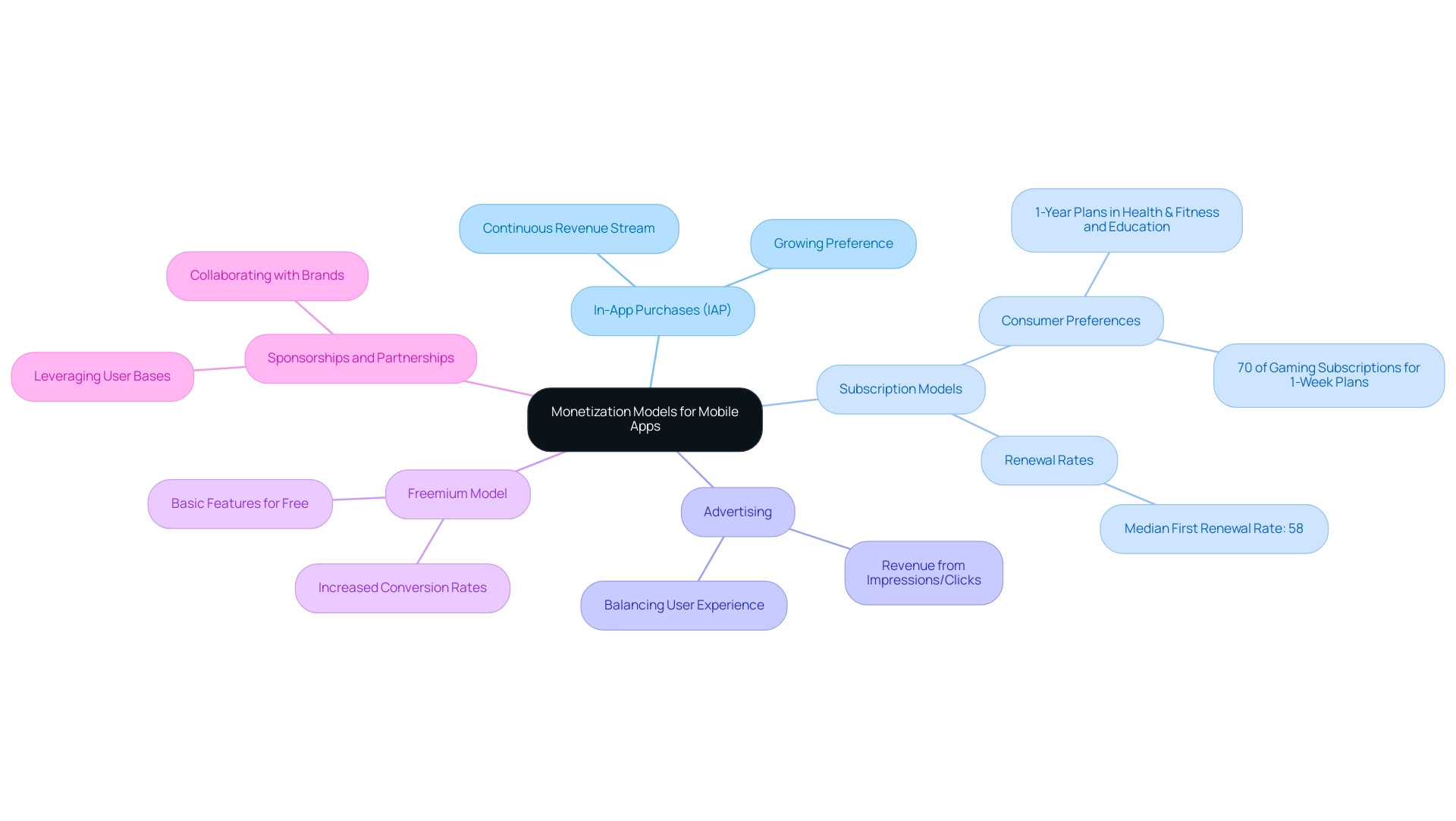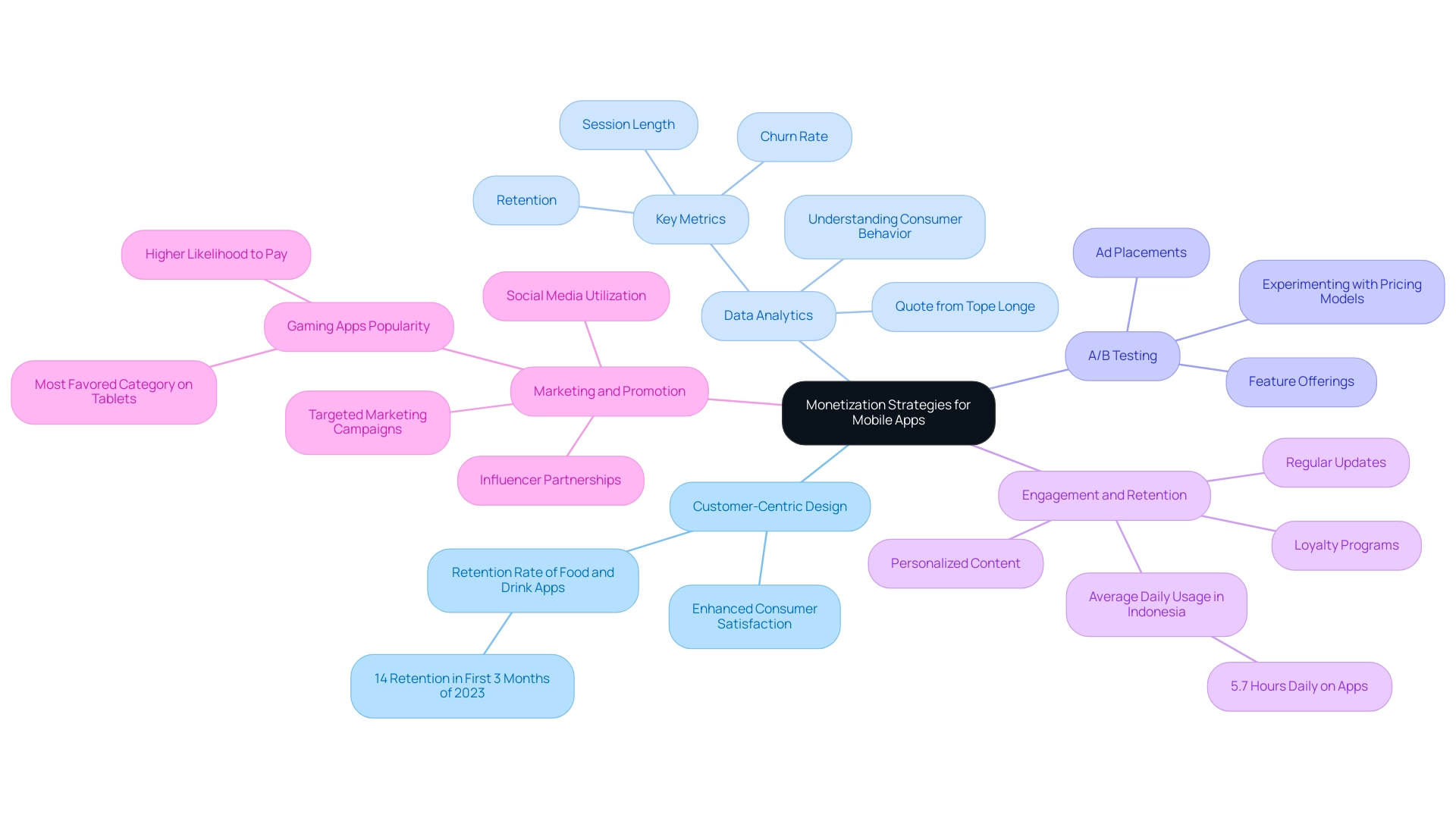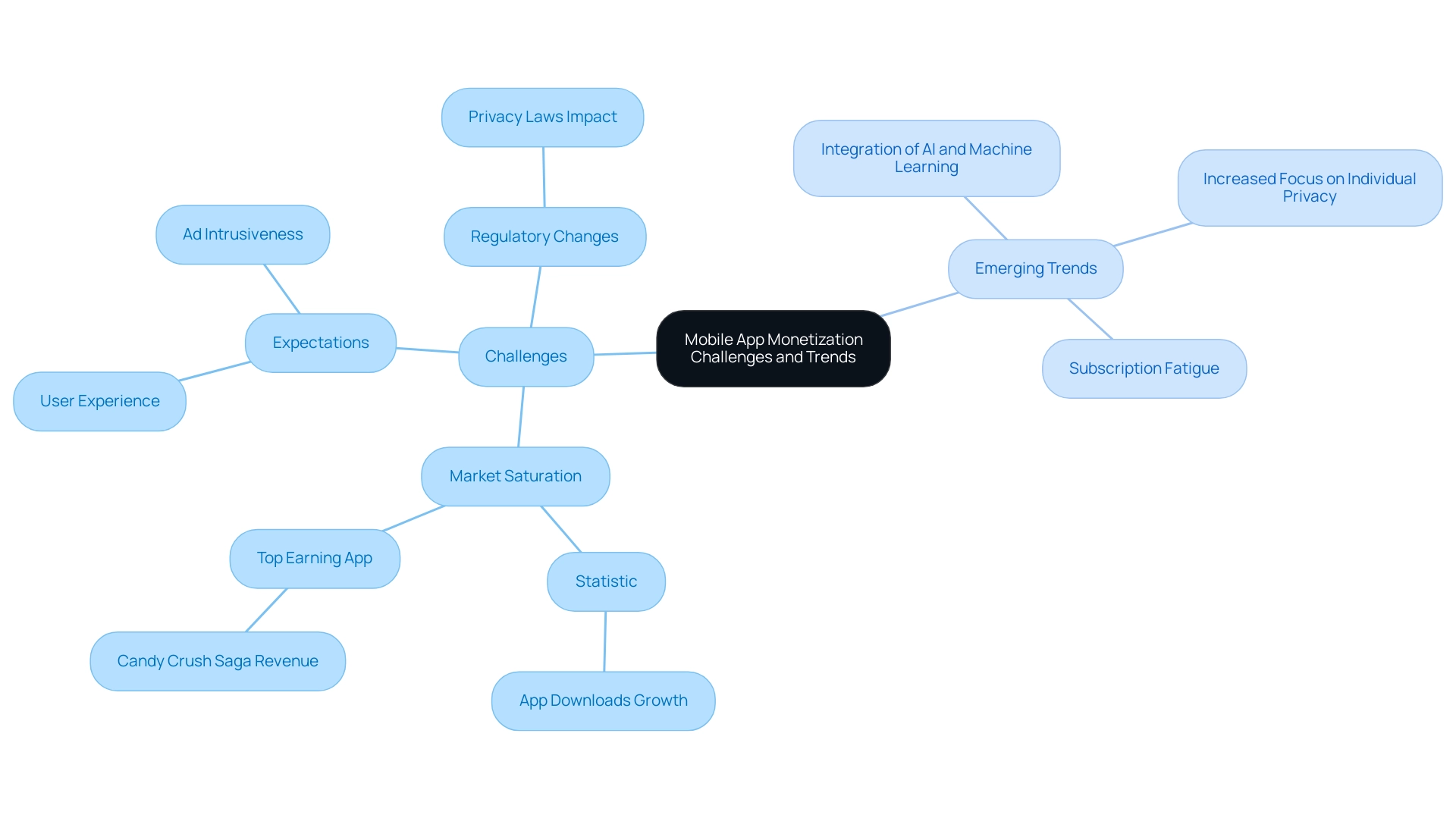Introduction
In the competitive realm of mobile applications, effective monetization is not merely an option but a necessity for developers striving for success. As the app market becomes increasingly saturated, understanding the diverse strategies for generating revenue is crucial for sustainability and growth.
From in-app purchases and subscription models to innovative advertising techniques, the landscape of mobile app monetization is rich with opportunities and challenges. By exploring key monetization models and implementing user-centric strategies, developers can not only enhance their revenue potential but also ensure that their applications resonate with users.
As trends evolve and user expectations shift, staying ahead of the curve is essential for any app developer aiming to thrive in this dynamic environment.
Understanding Mobile App Monetization: Definition and Importance
The monetization of mobile apps involves the strategic process through which creators earn income from their applications using a variety of methods such as in-app purchases (IAP), advertising, and sponsorships. This approach is essential for application creators and businesses, as the monetization of mobile apps not only supports operational sustainability but also funds ongoing development efforts and drives profitability. Techniques for the monetization of mobile apps include:
- Offering incentives
- Upselling
- Cross-selling
- In-app ads
- Sponsorships
These techniques can significantly enhance revenue streams.
The competitive environment of the app market enhances the significance of the monetization of mobile apps; developers must attract users and skillfully convert them into paying customers to thrive. Significantly, hypercasual games on Android that utilize an ads-only model often garner an impressive 64% of their revenue by Day 3, demonstrating the potential of the monetization of mobile apps through effectively executed revenue strategies. As mentioned by the Director of Product at Gameforge AI, smaller studios are increasingly seeking quicker returns on ad spend (ROAS), choosing hybrid revenue models that combine advertising with IAP to enhance their lifetime value (LTV).
Moreover, the retention of mobile app subscribers after one year in 2024 highlights the ongoing significance of strong revenue strategies for the monetization of mobile apps in sustaining engagement. In a market saturated with complimentary offerings and ad-supported applications, the lack of strong revenue strategies for the monetization of mobile apps can lead to even the most inventive apps facing financial challenges, highlighting the necessity for creators to focus on income generation to ensure their products not only endure but flourish. Insights from the case study titled '23 Tips from 23 Experts of eCommerce for Your Back-to-School Campaigns' can also be applied here, as expert advice on enhancing customer retention and personalizing marketing efforts can guide creators on how to engage their users more effectively.

Exploring Key Monetization Models for Mobile Apps
The monetization of mobile apps has evolved significantly, featuring several key models that offer unique advantages and challenges. Understanding these models is crucial for developers looking to maximize the monetization of mobile apps and their revenue potential. The primary methods for the monetization of mobile apps include:
-
In-App Purchases (IAP): This model enables individuals to acquire virtual goods or premium features within the app, generating a continuous revenue stream. Statistics indicate that in-app purchases are increasingly favored, contributing substantially to app revenue.
-
Subscription Models: With a growing trend in consumer preferences, especially in categories like Health & Fitness and Education, a recurring fee for premium content provides a reliable income source.
Significantly, individuals demonstrate a strong preference for 1-year subscription plans in these categories, while nearly 70% of Gaming subscriptions were for 1-week plans. The median first renewal rate in North America stands at 58%, indicating strong customer retention for these models. -
Advertising: By displaying ads, apps can earn revenue based on impressions or clicks, making this a popular option for free applications.
This model, however, must balance experience against revenue generation. -
Freemium Model: Users can access basic app features for free, with advanced features available for a fee. This approach attracts individuals to explore the app before committing to payment, effectively increasing conversion rates.
-
Sponsorships and Partnerships: Collaborating with brands for sponsored content presents additional revenue opportunities, leveraging existing user bases for mutual benefit.
The latest data reveals that gaming apps alone account for 28% of all apps available in China, highlighting the potential for targeted revenue strategies within specific app categories. Additionally, case studies on entertainment and streaming applications, such as Netflix's in-app purchase revenues and consumer spending on live-streaming apps, showcase successful monetization strategies that creators can learn from. By tailoring their approaches to these models, creators can effectively navigate the competitive landscape and enhance revenue outcomes through the monetization of mobile apps.

Effective Strategies for Monetizing Mobile Apps
To effectively monetize mobile apps in 2024, developers should adopt several key strategies:
- Customer-Centric Design: Prioritizing a seamless experience is crucial. Apps that enhance consumer satisfaction tend to see increased engagement and retention. Significantly, food and drink applications encountered a retention rate of approximately 14% during the initial three months of 2023, demonstrating the effect of consumer-focused design on revenue potential.
- Data Analytics: Utilizing analytics tools is crucial for comprehending consumer behavior and preferences. As Tope Longe, a Growth Marketing Manager, notes,
They can provide valuable insights into areas like retention, session length, daily or monthly active individuals, churn rate, and more. These insights allow developers to customize revenue strategies that correspond with client expectations in the monetization of mobile apps. - A/B Testing: Implementing A/B testing enables developers to experiment with various pricing models, ad placements, and feature offerings. This iterative approach helps identify the most effective elements for enhancing satisfaction and revenue generation.
- Engagement and Retention: Keeping individuals engaged is vital for the monetization of mobile apps. Regular updates, loyalty programs, and personalized content can significantly enhance customer retention. For instance, Indonesians average 5.7 hours daily on apps, indicating a substantial opportunity for maintaining engagement through thoughtful, ongoing interactions. This statistic highlights the potential for creators to design engaging experiences that support the monetization of mobile apps, leveraging the considerable time individuals spend on applications.
- Marketing and Promotion: Targeted marketing campaigns are essential in attracting individuals who are likely to convert into paying customers. Utilizing social media and forming partnerships with influencers can amplify outreach efforts, ensuring the app reaches its intended audience effectively. With gaming applications being the most favored category on tablets, where individuals are more inclined to pay due to the immersive experience, creators can leverage this popularity by crafting tailored marketing strategies that highlight the enhanced gaming experience on larger screens. This method not only draws in participants but also enhances revenue potential.

Navigating Challenges and Trends in Mobile App Monetization
Mobile application revenue generation faces numerous obstacles that developers must strategically manage:
-
Market Saturation: The mobile app ecosystem is flooded with millions of choices, making it progressively challenging for new and existing applications to differentiate themselves and draw in audiences effectively. Laura Ceci notes a concerning trend:
App downloads experienced a slowing growth trend between 2022 and 2023, reaching 257 billion installs, up by less than one percent year-over-year.
This statistic highlights the intense competition apps encounter in capturing audience attention. Significantly, the highest-earning application in the US, Candy Crush Saga, produced $485 million in consumer expenditures, demonstrating effective revenue strategies even in a crowded market. -
Expectations: Today's individuals require high-quality, seamless experiences while showing a strong dislike for intrusive advertising. Developers must strike a delicate balance between the monetization of mobile apps and customer satisfaction, ensuring that ads do not detract from the overall app experience.
-
Regulatory Changes: The landscape of app revenue generation is also shaped by compliance with evolving privacy laws. Regulations can significantly impact how applications gather data from individuals and promote themselves, necessitating a thoughtful approach to the monetization of mobile apps.
Emerging trends to monitor include:
-
Increased Focus on Individual Privacy: As awareness of data privacy expands, creators are challenged to adapt their revenue tactics to respect individual preferences regarding data collection and advertising.
-
Integration of AI and Machine Learning: Utilizing AI technology can greatly enhance engagement and optimize ad placements, leading to improved revenue efficiency. This technological advancement offers a valuable opportunity for creators to innovate in their advertising strategies.
-
Subscription Fatigue: With a proliferation of subscription services, individuals are becoming discerning about their spending. By staying informed about these challenges and trends, app developers can navigate the continually evolving landscape of monetization of mobile apps with greater confidence and effectiveness, particularly as they may need to reevaluate their pricing models to retain customer interest and loyalty.

Conclusion
The landscape of mobile app monetization is both complex and dynamic, presenting a myriad of opportunities for developers. By understanding the various monetization models—such as in-app purchases, subscription services, advertising, and sponsorships—developers can tailor their strategies to optimize revenue generation while enhancing user experience. It is crucial to implement user-centric design principles and leverage data analytics to create engaging applications that not only attract users but also keep them coming back.
As the market becomes increasingly saturated, effective monetization strategies become paramount for survival and growth. Developers must navigate challenges such as user expectations for seamless experiences, regulatory changes, and the competition for user attention. By embracing innovative approaches, such as A/B testing and targeted marketing campaigns, developers can significantly improve their chances of success in a crowded marketplace.
In conclusion, the future of mobile app monetization lies in the ability to adapt to evolving trends and user preferences. By prioritizing user satisfaction and continuously refining monetization strategies, developers can ensure their applications not only thrive but also resonate with a diverse audience. The key to success is a proactive approach that balances revenue generation with the creation of valuable user experiences, ultimately leading to sustainable growth in an ever-competitive environment.





